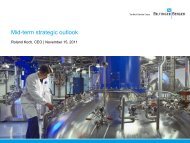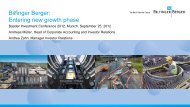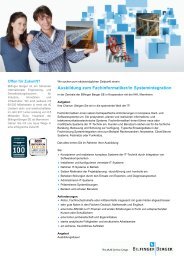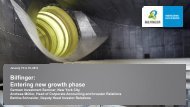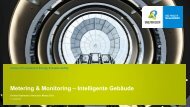iMaintenance - Bilfinger
iMaintenance - Bilfinger
iMaintenance - Bilfinger
- No tags were found...
Create successful ePaper yourself
Turn your PDF publications into a flip-book with our unique Google optimized e-Paper software.
The idea behind <strong>iMaintenance</strong>Democase Hannover Messe 2013Production goals▪ High availability and reliability▪ Minimum costs with a fixed yield rate▪ “Extremum” principleDeterminants▪ Avoidance of unplanned down times▪ Condition-driven servicing and inspection<strong>iMaintenance</strong>: “work determined by the condition of the plant”<strong>iMaintenance</strong> – next-generation maintenance via intelligent applications page 3
<strong>iMaintenance</strong> - the ideaExisting situationDemocase Hannover Messe 2013Static maintenance intervals:▪ No review of the maintenance intervals▪ No allowance made for use-based capacity utilisation▪ Environmental conditions not factored inPurpose of <strong>iMaintenance</strong>To determine the optimum maintenance interval<strong>iMaintenance</strong> – next-generation maintenance via intelligent applications page 4
<strong>iMaintenance</strong> – the ideaExisting situationDemocase Hannover Messe 2013Maintenance and inspection is scheduled on a time basisregardless of the condition and utilisation of the plantProblem• Maintenance intervals static and scheduled on a timebasis• No check of the time-based intervals in the life cycleof the industrial asset• No feedback from maintenance staff on themaintenance performed• No link between plant management and maintenanceinstrumentsEffect• Generally more maintenance performed than required• Occasional down time even after (time-based)inspection• Intervals remain static due to lack of information onduration and insufficient ability to assess the plant(as well as a lack of process data)• No early error detection possible<strong>iMaintenance</strong> – next-generation maintenance via intelligent applicationspage 5
Subjective evaluationStatic vs. dynamic intervalDemocase Hannover Messe 2013Static intervalUse of a mobile terminalDoes not take into account the extent of utilisation of theasset or the environment factors.<strong>iMaintenance</strong> – next-generation maintenance via intelligent applications page 7
Subjective evaluationStatic vs. dynamic intervalDemocase Hannover Messe 2013Static intervalDynamic intervalDoes not take into account the extent of utilisation of theasset or the environment factors.<strong>iMaintenance</strong> – next-generation maintenance via intelligent applications page 8
Modular structureOverviewDemocase Hannover Messe 2013intelligent MaintenanceModule 3Module 2Module 1Multi-variant diagnoses• Automatic error pattern detection• Duration forecastsCondition-based maintenance – extended• Adoption of utilisation-based scheduling of maintenance plans (automatic)• Measurements coupled to actionsCondition-based maintenance – basic version• Assessment of maintenance performed by the maintenance staff• Adoption of utilisation-based scheduling of maintenance plans (manual)Definition of critical items by RCM<strong>iMaintenance</strong> – next-generation maintenance via intelligent applicationspage 9
Modular structureModule 1Democase Hannover Messe 2013Assessment of maintenance performed by the maintenance staff• Use of mobile devices• Evaluation of the maintenance/inspection performedModule 1in time too early too late• Progressive determination of the optimum interval for each itemof equipment• Evaluation and decision documentedModule2Manual adoption of utilisation-based scheduling of maintenance plansModule 3• Adoption of meter-based scheduling• Cyclical recorder of meter data (e.g. operating hours)+ Minor investment-Resource requirements formaintenance activities<strong>iMaintenance</strong> – next-generation maintenance via intelligent applicationspage 10
Modular structureModule 2Democase Hannover Messe 2013Automatic adoption of utilisation-based scheduling of maintenanceschedules linked to existing plant management/sensor systems• Adoption of meter-based schedulingModule 1+ Automation- Investment necessaryMeasurements coupled to actionsModule2• Linked to existing plant management/sensor systems• Combination of various measurements, e.g. temperature, vibration etc.Module 3Target-oriented management Extensive plant expertise+ -necessaryof activities<strong>iMaintenance</strong> – next-generation maintenance via intelligent applicationspage 11
Modular structureModule 3Democase Hannover Messe 2013Implementation of new knowledge-base maintenance schedules• Data mining by means of assessment systems based on computercontrolledstatistical knowledge trees• Postponement of inspection dates, under permanent observationby a server-based system.Module 1• Step towards prediction of service lifeModule2High level ofplant integrity+ - Investment necessary /functionality only aftera corresponding volumeof data in the systemModule 3<strong>iMaintenance</strong> – next-generation maintenance via intelligent applicationspage 12
Added valueCustomer benefitsDemocase Hannover Messe 2013CostsExpense 1Expense 21<strong>iMaintenance</strong> resultsin optimisation ofmaintenance costs2Fixed timebasedintervalCondition-basedinterval<strong>iMaintenance</strong> – next-generation maintenance via intelligent applicationspage 13
System architectureOverviewDemocase Hannover Messe 2013<strong>iMaintenance</strong>enginius® MiddlewareApplication serverConsoleMachinery andsensors<strong>iMaintenance</strong> – next-generation maintenance via intelligent applicationspage 14
Global contact<strong>Bilfinger</strong> Industrial ServicesThomas-Peter WilkTel: +49 89 149 98 387E-Mail: thomas-peter.wilk@bilfinger.comContact for operational matters<strong>Bilfinger</strong> Maintenance SüdwestFranz BraunTel: +49 6224 701 422E-Mail: franz.braun@bilfinger.comOliver WichmannTel: +49 6202 578 157 0E-Mail: oliver.wichmann@bilfinger.com



